词汇学Lexicology Chapters 1-3 for students
- 格式:doc
- 大小:45.50 KB
- 文档页数:3
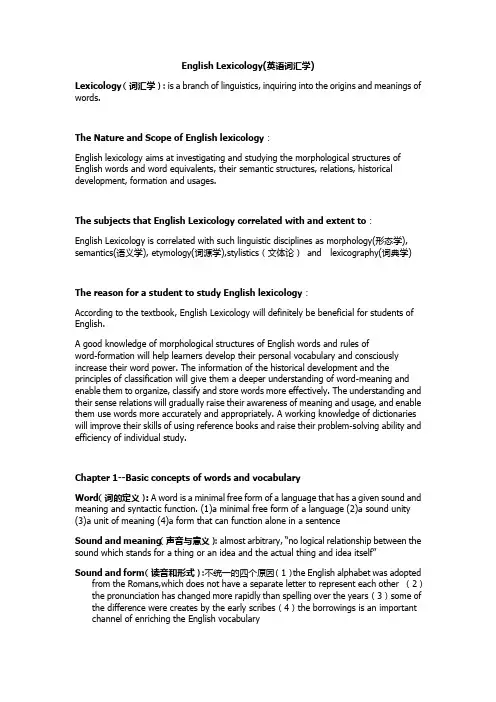
English Lexicology(英语词汇学)Lexicology(词汇学): is a branch of linguistics, inquiring into the origins and meanings of words.The Nature and Scope of English lexicology:English lexicology aims at investigating and studying the morphological structures of English words and word equivalents, their semantic structures, relations, historical development, formation and usages.The subjects that English Lexicology correlated with and extent to:English Lexicology is correlated with such linguistic disciplines as morphology(形态学), semantics(语义学), etymology(词源学),stylistics(文体论)and lexicography(词典学) The reason for a student to study English lexicology:According to the textbook, English Lexicology will definitely be beneficial for students of English.A good knowledge of morphological structures of English words and rules ofword-formation will help learners develop their personal vocabulary and consciously increase their word power. The information of the historical development and the principles of classification will give them a deeper understanding of word-meaning and enable them to organize, classify and store words more effectively. The understanding and their sense relations will gradually raise their awareness of meaning and usage, and enable them use words more accurately and appropriately. A working knowledge of dictionaries will improve their skills of using reference books and raise their problem-solving ability and efficiency of individual study.Chapter 1--Basic concepts of words and vocabularyWord(词的定义): A word is a minimal free form of a language that has a given sound and meaning and syntactic function. (1)a minimal free form of a language (2)a sound unity (3)a unit of meaning (4)a form that can function alone in a sentenceSound and meaning(声音与意义): al most arbitrary, “no logical relationship between the sound which stands for a thing or an idea and the actual thing and idea itself”Sound and form(读音和形式):不统一的四个原因(1)the English alphabet was adopted from the Romans,which does not have a separate letter to represent each other (2)the pronunciation has changed more rapidly than spelling over the years(3)some of the difference were creates by the early scribes(4)the borrowings is an important channel of enriching the English vocabularyVocabulary(词汇): all the words in a language make up its vocabularyClassification of English Words:By use frequency:basic word stock&nonbasic vocabularyBy notion:content words&functional wordsBy origin:native words&borrowed wordsThe basic word stock(基本词汇): is the foundation of the vocabulary accumulated over centuries and forms the common core of the language. Though it constitute a small percentage of the EV, it is the most important part of vocabulary.The Fundamental Features of the Basic Word Stock(基本词汇的特征):1)All-National character(全民通用性most important)2)Stability(相对稳定性)3)Productivity(多产性)4)Polysemy(多义性)5)Collocability(可搭配性)没有上述特征的words:(1)Terminology(术语) (2)Jargon(行话)(3)slang(俚语)(4)Argot(暗语)(5)Dialectal words(方言) (6) Archaisms(古语)(7) Neologisms(新词语):Neologisms means newly-created words or expressions, or words that have taken on new meanings.(email)Content words/notional words实词(cloud, run walk, never, five, frequently) and functional words/empty words虚词(on, of, and, be, but)Native Words and Borrowed WordsNative words(本族语词): known as Anglo-Saxon words (50,000-60,000), are words brought to Britain in the 5th century by the Germanic tribes. (mainstream of the basic word-stocks).Two other features:(1)neutral in style (2)frequent in useBorrowed words/Loan words(外来语词): words taken over from foreign languages.(80% of modern EV)4 Types of loan words:1) denizens(同化词): (shirt from skyrta(ON))2) aliens(非同化词/外来词):are borrowed words which have retained their original pronunciation and spelling (kowtow (CH)磕头)3) translation loans(译借词):按其他语言方式组成英语long time no see (from China)4) semantic loans(借义词):they are not borrowed with reference to the form,but their meanings are borrowedChapter 2 the development of the English VocabularyThe Indo-European Language Family(印欧语系)The Eight Groups in Indo-European Family of Languages(8大印欧语群)The Eastern set:(1)The Balto-slavic Group(波罗的-斯拉夫语族):Russian,Bulgarian,Polish,Czech etc. (2)The Indo-Iranian Group(印度-伊朗语族):Hindi,Bengali,Persian etc.(3)The Armenian Group(亚美尼亚语族):Armenian.(4)The Albanian Group(阿尔巴尼亚语族):Albanian.The Western set:(5)The Hellenic Group(古希腊语族):Greek.(6)The Italian Group(意大利语族):Latin ,Romance languages(French,Italian,Spanish, portuguese,Romanian) etc.(7)The Celtic Group(凯尔特语族):Irish,Welsh,Breton etc.(8)The Germanic Group(日耳曼语族):Flemish,German,Dutch,Scandinavian(Norweigian, Swedish,Danish,Icelandic) etc.The Three Stages of Development of the English Vocabulary:1 Old English (450-1100) (vocabulary 50,000 to 60,000):was I high inflected language.2 Middle English (1150-1500):retaines much fewer inflections3 Modern English (1500-up to now): in fact more than 25% of modern E words come almost directly from classical languages. In Modern E, words endings were mostly lost with just a few expections.English has evolved from a synthetic language(Old English) to the present analytic language.Modes of Vocabulary Development(词汇的发展模式):1)creation创造新词:the formation of new words by using the existing materials,namely toots,affixes and other elements.(最重要方式)2)semantic change旧词新义:does not increase the number of word forms but create many more new useages of the words.3) borrowing借用外来词:constitute merely 6 to 7 percent of all new wordsReviving words or obsolete words also contributes to the growth of English vocabulary though quite insignificant.Chapter 3 Word Formation IMorpheme(词素):the smallest functioning unit in the composition of words Allomorph(词素变体): is a different variant form of a morpheme,differ in phonological and spelling form, but at the same in function and meaningType of Morpheme(词素的分类)(1)Free Morphemes(自由词素): have complete meaning in themselves and can be used as free grammatical units in sentences. A free morpheme is one that can stand by itself. (independent).(2)Bound Morpheme(粘着语素): A bound morpheme is one that cannot stand by itself. Bound Morpheme includes two types: (1) bound root(粘附词根) (2)Affix(词缀)Affixes can be put into two groups:1)Inflectional affixes (屈折词缀):affixes attached to the end of words to indicate grammatical relationships are inflectional,thus known as inflectional morphemes.2)Derivational affixes(派生词缀): A) prefix: A prefix comes before words. B)suffix:An adjective suffix(形容词后缀)that is added to the stem, whatever class is belongs to , the result will be an adjective.Free Morpheme =free root(自由词根)Morpheme(词素)Bound root prefixbound derivationalaffix suffixinflectionalRoot and stem(词根和词干)The differences between root and stem:A root is the basic form of a word which cannot be further analyzed without total loss of identity.A stem is the surplus part after the cutting of inflectional morpheme in a word with inflectional morphemes,can be further analyzed, it sometimes could be a root.Chapter 4 Word-Formation II(构词法)1.Affixation词缀法(Derivation派生法):the formation of words by adding word-formaing or derivational affixes to stem.(1)Prefixation(前缀法):It's the formation of new words by adding a prefixes to stems.1)Negative prefixes(否定前缀): un-,non-,in-,dis,a- ,il-,ir-,im-,etc.disobey(not obey)2)Reversative prefixes(逆反前缀): un-,de-,dis- etc. unwrap(open)3) Pejorative prefixes: mis(贬义前缀):mis-,mal-, pseudo- etc.misconduct(bad behaviour)4) Prefixes of degree or size(程度前缀):arch-,extra-,hyper-,macro-,micro-,mini-,out-,over-,sub-,super-,sur-,ultra-,under-,ect. overweight5) Prefixes of orientation and attitude(倾向态度前缀):contra-,counter-,anti-,pro- etc.anti-nuclear6)Locative prefixes(方位前缀):extra-,fore-,inter-,intra-,tele-,trans-, etc. extraordinary(more than ordinary)7) Prefixes of time and order(时间和顺序前缀):fore-,pre-,post-,ex-,re- etc. monorail(one rail)8) Number prefixes(数字前缀):uni-,mono-, bi-,di-, tri-,multi-,poly- ,semi-,etc.bilingual(concerning two languages)9) Miscellaneous prefixes(混杂前缀):auto-, neo-, pan-, vice-.vice-chairman(deputy chairman)(2)Suffixation(后缀法): It's the formation of a new word by adding suffixes to stems.1)noun suffixes 2)adjective suffixes 3)Adverb suffixes 4)verb suffixespounding复合法(also called composition)Compounding: is the formation of new words by joining two or more stemsCompounds are written in three ways: solid连写(airmail),hyphenated带连字符(air-conditioning)and open分开写(air force, air raid)Formation of compounds(复合词的形式)(1)noun compounds :e.g. : air + plane = airplane,flower + pot = flower pot(2)adjective compounds :e.g. acid + head = acid-head(3)verb compounds :e.g. house + keep = housekeep3.Conversion转类法Conversion: is the formation of new words by converting words of one class to another class.(功能转换,又叫零派生.functional shift/zero-derivation)4.Blending拼缀法Blending : is the formation of new words by combining parts of two words or a word plus a part of another word. e.g: motor + hotel = motel, smoke + fog = smog, formula + translation = FORTRAN5.Clipping截短法Clipping:is to shorten a longer word by cutting a part off the original and using what remains instead.e.g. plane from airplane, phone from telephone. 四种形式:1).Front clippings删节前面(phone from telephone)2).Back clippings删节后面(dorm from dormitory)3).Front and back clippings 前后删节(flu from influenza)4).Phrase clippings 短语删节(pop from popular music)6.Acronymy首字母缩写法Acronymy:is the process of forming new words by joining the initial letters of names of social and political organizations or special noun phrases and technical terms.(1)Initialism(首字母缩写词法): initialisms are words pronounced letter by letter. e.g.: BBC(for British Broadcasting corporation)(2)Acronym(首字母拼音法):Acronyms are words formed from initial letters but pronounced as a normal word. E.g.:TEFL(teaching English as a foreign language)7.Back-formation(逆生法,逆构词)Back-formation is considered to be the opposite process of suffixation. It’s the method of creating words by removing the supposed suffixes. (greed from greedy)8.Words From Proper Name(专有名词转成法):Names of people, places, book, and tradenames (e.g.: sir watt siemens(人名) -- watt(瓦特,电功率单位)Chapter 5 Word MeaningThe meanings of “Meaning”(“意义”的意义)Reference(所指):It is the relationship between language and the word. It is the arbitrary and conventional. It is a kind of abstraction, yet with the help of context, it can refer to something specific.Concept(概念):which is beyond language, is the result of human cognition(认识),reflecting the objective world in the human mind.Sense(意义):It denotes the relationship inside the language. ‘The sense of an expression is its place in a system of semantic relationships with other expressions in the language.’Motivation(理据):It accounts for the connection between the linguistic symbol and its meaning.1) Onomatopoeic motivation(拟声理据):words whose sounds suggest their meaning, for these words were creates by imitating the natural sounds or noises. Knowing the sounds of the words means understanding the meaning. E.g.: bang, ping-pong, ha ha.2)Morphological motivation (形态理据):multi-morphemic words and the meaning of many are the sum total of the morphemes combines. E.g.: airmail, miniskirt .例外:black market, ect.3)Semantic motivation(词义理据):refers to the mental associations suggested by the conceptual meaning of a word. It explains the connection between the literal sense and figurative sense of the word. E.g:the foot of the mountain(foot)4)Etymological motivation (词源理据):the history of the word explains the meaning of the word. E.g:pen-featherTypes of meaning(词义的类别)1.Grammatical Meaning(语法意义):indicates the grammatical concept or relationships (becomes important only in actual context)2.Lexical Meaning (词汇意义)(Lexical meaning and grammatical meaning make up the word-meaning)Lexical meaning has 2 components内容: Conceptual meaning(概念意义) and associative meaning(关联意义)1)Conceptual meaning(概念意义): also known as denotative meaning(外延意义) is the meaning given in the dictionary and forms the core of word-meaning.2)Associative meaning(关联意义):is the secondary meaning supplemented to the conceptual meaning.[4types:(1)Connotative(内涵意义):the overtones or associations suggested by the conceptual meaning, traditionally known as connotations.(例如“母亲”经常与“爱”“关心”“温柔”联系起来)(2)Stylistic(文体意义):many words have stylistic features, which make them appropriate for different contexts.(3)Affective(感情意义):indicates the speaker’s attitude towards the person or thing in question.这种情感价值观分两类:褒义和贬义appreciative & pejorative(4)Collocative(搭配意义):is the part of the word-meaning suggested by the words before or after the word in discussion.]Chapter 6 --Sense relation and semantic field(语义关系和语义场)Polysemy(多义关系)Two approached to polysemy(多义关系的两种研究方法):1.diachronic approach(历时方法) :from the diachronic point of view, polysemy is assumed to be the result of growth and development of the semantic structure of one and same word. First meaning is the primary meaning , the later meanings are called derived meanings.2. synchronic approach (共时方法) : synchronically, polysemy is viewed as the coexistence of various meanings of the same word in a certain historical period of time.基本意义是central meaning , 次要意义是derived meaning.Two processes of development(词义的两种发展类型):1.radiation(辐射型):is a semantic process in which the primary meaning stands at thecentre and the secondary meanings proceed out of it in every direction like rayes. (e.g: face, neck)2.concatenation(连锁型):is the semantic process in which the meaning of a word movegradually away from its first sense by successive shifts until there is not a sign of connection between the sense that is finally developed and that which the term had at the beginning.(e.g:treacle)3.In radiation, each of the derived meaning is directly connected to the primary meaning.In concatenation, each of the later meaning is related only to the preceding one like chains. Though the latest sense can be traced back to the original, there is no direct connection in between.4.They are closely related, being different stages of the development leading topolysemy. Generally, radiation precedes concatenation. In many cases, the two processes work together, complementing each other.Homonymy(同形同音异义关系):words different in meaning but either identical both in sound and spelling or identical only in sound or spelling.Types of homonyms(同音同形异义关系的类别)1)Perfect homonyms(完全同音同形异义词):words identical both in sound and spelling, but different in meaning.2)Homographs(同形异义词):words identical only in spelling, but different in sound and meaning.(最多最常见)3)Homophones(同音异义词):words identical only in sound but different in spelling and meaning.Origins of homonyms (同形同音异义词的来源)1)change in sound and spelling :(eare-ear, lang-long, langian-long)2)borrowing (feria-fair, beallu-ball, baller-ball )3)Shortening(缩略): (ad-advertisement,)The differentiation of Homonyms from Polysemes(同音同形异义词和多义词的区别):1)The fundamental difference : Homonymy refers to different words which happen to share the same form and polysemy are the one and same word which has several distinguishable meanings.2)One important criterion is to see their etymology(词源):Homonymys are from different sources. Polysemant is from the same source.3)The second principle consideration is semantic relatedness(语义关联): The various meanings of polysemant are correlated and connected to one central meaning. Meanings of different homonymys have nothing to do with one another. In dictionaries, a polysemant has its meaning all listed under one headword whereas homonyms are listed as separate entries.Rhetoric features of homonyms(同形同音异义词的修辞特色):As homonyms are identical in sound or spelling, particularly homophones, they are often employed to create puns for desired effect of, say, humor, sarcasm or ridicule.Synonymy (同义关系): one of two or more words in the English language which have the same or very nearly the same essential meaning .Types of Synonymy(同义词的类别) :(1)Absolute synonyms(完全同义词):also known as complete synonyms are words whichare identical in meaning in all aspects, i.e. both in grammatical meaning and lexical meaning, including conceptual and associative meanings.[ Absolute synonyms are restricted to highly specialized vocabulary in lexicology. ](2)relative synonyms(相对同义词):also called near-synonyms are similar or nearly thesame in denotation, but embrace different shades of meaning or different degrees of a given quality.(e.g: change/alter/vary, stagger/reel/totter, strange/odd/queer, idle/lazy/indolent)Sources of synonyms(同义词的来源) :1)Borrowing(借词):最重要的来源(room-chamber, foe-enemy, help-aid, leave-depart, wise-sage, buy-purchase)2)Dialects and regional English (方言和地区英语)3)Figurative and euphemistic use of words (单词的修饰和委婉用法):occupation/profession-walk of life, dreamer--star-gazer, drunk-elevated, lie-distort of fact.4)Coincidence with idiomatic expressions(与习惯表达一致):win-gain the upper hand, decide-make up one’s mind, finish-get through, hesitate-be in two minds, help-lend one a hand.Discrimination of Synonyms(1)difference in denotation外延不同. Synonyms may differ in the range and intensity ofmeaning.(rich-wealthy, work-toil, want-wish-desire)(2)difference in connotation内涵不同. By connotation we mean the stylistic and emotivecolouring of words. Some words share the same denotation but differ in their stylistic appropriateness. (借词:answer-respond, storm-tempest, wood-forest, handy-manual, unlike-dissimilar, homely-domestic, fleshy-carnal.中性词:policeman-constable-bobby-cop, ask-beg-request. 古语词、诗歌:ire/anger, bliss-happiness, forlorn-distresses, dire-dreadful, list-listen, enow-enough, save-expect, mere-lake )(3)difference in application. Many words are synonymous in meaning but difference inusage in simple terms. They form different collocations and fit into difference sentence patterns. (allow sb. to do sth.- let sb. do sth. / answer the letter-reply to the letter) Antonymy (反义关系) :it is concerned with semantic opposition. Antonyms can be defined as words which are opposite in meaning.Types of Antonyms:1)contradictory terms (矛盾反义词): these antonyms truly represent oppositeness of meaning. 特点:①The assertion of one is the denial of the other. ②Such antonyms are non-gradable. They cannot be used in comparative degrees and do not allow adverbs ofintensity like “very” to qualify them . (e.g: single/married)2)contrary terms(对立反义词): antonyms of this type are best viewed in terms of a scale running between two poles or extremes.(e.g: old/young, rich/young, big/small) The two opposites are gradable and one exists in comparison with the other.3)relative terms(关系反义词):this type consists of relational opposites.(parent/child, husband/wife, employee/employer, sell/buy, receive-give)Some of the characteristics of antonyms(反义关系的特点):1)antonyms are classified on the basis of semantic opposition(语义对立)2)a word which has more than one meaning can have more than one antonym3)antonyms differ in semantic inclusion(语义内涵)4)contrary terms are gradable antonyms,differing in degree of intensity, so each has its own corresponding opposite.(hot/warm: hot-cold/warm-cool)The use of antonyms(反义词的使用)1)Antonyms are helpful and valuable in defining the meaning of words.2)To express economically the opposite of a particular thought for the sake of contrast.(e.g :now or never, rain or shine, friend or foe敌友,weal and woe哀乐)3)To form antithesis(对比法) to achieve emphasis by putting contrasting idea together. (proverbs and sayings: easy come , easy go./ more haste, less speed.)Hyponymy(上下义关系): Hyponymy deals with the relationship of semantic inclusion. The meaning of a more specific word is included in that of another more general word. For example, a cat is hyponym of animalSuperordinate and Subordinate (上义词和下义词):use subordinates which are concrete and precise ,presenting a vivid verbal picture before the reader. Superordinates which convey only a general and vague idea.Semantic Field(语义场)Viewing the total meaning in this way is the basis of field theory.e.g.(apple, pear, peach, date, mango, orange, lemon, etc. make up the semantic field of ‘fruits’)The semantic field of the same concept may not have the same members in different language.e.g.(aunt in English, may means “父亲的姐姐,妈妈的姐姐,父亲哥哥的妻子” in Chinese.(122)Chapter 7 Changes in Word Meaning词义的演变Vocabulary is the most unstable element of a language as it is undergoing constant changes both in form and content. Comparatively the content is even more unstable than the form.Types of Changes (词义变化的种类)1.Extension /generalization(词义的扩大): is the name given to the widening of meaning which some words undergo. It is a process by which originally had a specialized meaning has now become generalized.(e.g: manuscript, fabulous, picture, mill, journal, bonfire, butcher, companion)2.Narrowing/ specialization(词义的缩小):is the opposite of widening meaning. It isa process by which a word of wide meaning acquires a narrower or specialized sense. Inother words, a word which used to have a more general sense becomes restricted in its application and conveys a special meaning in present-day English.(e.g: deer, corn, garage, liquor, meat, disease, poison, wife, accident, girl). [ when a common word is turned into a proper noun, the meaning is narrowed accordingly. ]3.Elevation /amelioration(词义的升华):refers to the process by which words rise from humble(粗陋的)beginnings to positions of importance. [nice, marshal, constable, angel, knight, earl, governor, fond, minister, chamberlain ]4.Degradation / pejoration(词义的降格):A process whereby words of good origin fall into ill reputation or non-affective words come to used in derogatory(贬损的)sense.[boor, churl, wench, hussy, villain, silly, knave, lewd, criticize, lust ]5.Transfer(词义的转移): Words which were used to designate指明one thing but later changed to mean something else have experienced the process of semantic transfer.Causes of Semantic Change(词义变化的原因)1.Extra-linguistic factors(词义演变的语言外部因素):1) Historical reason(历史原因):Increased scientific knowledge and discovery, objects, institutions, ideas change in the course of time. E.g: pen, car, computer.2 )Class reason(阶级原因):The attitude of classes have also made inroads into lexical meaning in the case of elevation or degradation.3) Psychological reason(心理原因):the associated transfer of meaning and euphemistic use of words are often due to psychological factors. Such slow, humble and despised occupations take more appealing names is all due to psychological reasons.2.Linguistic factors(语言内部原因):the change of meaning may be caused by internal factors with in the language system.1)shorting缩略:gold-gold medal, gas-coal gas, bulb-light bulb, private-private soldier2)borrowing借用:deer-animal-beast3)analogy类推:Chapter 8 Meaning and Context 词义和语境Context in its traditional sense refers to the lexical items that precede or follow a given word. Modern linguists have broadened its scope to include both linguistic andextra-linguistic contexts.Two types of context(语境的种类)1. Extra-linguistic context/ Non-linguistic situation(非语言语境):In a broad sense, context includes the physical situation as well, which embraces the people, time, place, and even the whole cultural background. (look out, weekend, landlord )2.Linguistic context/ grammatical context(语言语境):In a narrow sense, it refers to the words, clauses, sentences in which a word appears. It may cover a paragraph, a whole chapter and even the entire book.分为两类:1) Lexical context(词汇语境):It refers to the word that occurs together with the word in question. (e.g: paper, do)2) Grammatical context(语法语境):It refers the situation when the meaning of a word may be influenced by the structure in which it occurs. (e.g: become)The role of context(语境的作用)1.Elimination of ambiguity(消除歧义)1)Ambiguity due to polysemy or homonymy.2)Grammatical structure can also lead to ambiguity如何消除歧义?——①extend the original sentence ②alter the context a little2.Indication of referents(限定所指)如何限定所指?——①with clear context ②with adequate verbal context3.Provision of clues for inferring word-meaning (提供线索以猜测词义)1)definition2)explanation3)example4)synonymy5)antonymy6)hyponymy(上下义关系)7)relevant details8)word structureChapter 9 English Idioms 英语习语Idioms(习语的定义): are expressions that are not readily understandable from their literal meaning of individual elements. In a broad sense, idiom may include colloquialisms (俗语), Catchphrases(标语),slang expressions (俚语),proverbs(谚语),etc. They form an important part of the English vocabulary.Characteristics of Idioms(英语习语的特点)1.Semantic unity (语意的整体性):words in the idiom they have lost their individual identity. Their meanings are not often recognizable in the meaning of the whole idiom. The semantic unity of idioms is also reflected in the illogical relationship between the literalmeaning of each of the idiom.2.Structural stability(结构的稳定性):the structure of an idiom is to a large extent un changeable.1) the constituents of idioms cannot be replaced2) the word order cannot be inverted or changed3) the constituents of idioms cannot be deleted or added to, not even an article.4) many idioms are grammatically unchangeableThe fixity of idiom depends on the idiomaticity.习语性表达习惯Classification of Idioms(英语习语的分类)1. idioms nominal in nature 名词性习语(white elephant累赘物)2 .idioms adjectival in nature形容词性习语(as poor as a church mouse)3 .idioms verbal in nature 动词性习语(look into)4 .idioms adverbial in nature副词性习语(tooth and nail 拼命)5 .sentence idioms 句式习语(never do things by halves)Use of idioms(习语的使用)1.Stylistic features(文体色彩):1)colloquialisms(俗语)2)slang (俚语)3)literary expressions(书面表达)The same idiom may show stylistic differences when it is assigned(指派)different meanings.2.Rhetorical features(修辞色彩)1) phonetic manipulation (语音处理):(1)alliteration头韵法(2)rhyme尾韵法2)lexical manipulation(词法处理)(1)reiteration(duplication of synonyms)同义词并举[scream and shout] (2)repetition 重复[out and out](3)juxtaposition (of antonyms) 反义词并置[here and there]3.figures of speech(修辞格)(1)simile明喻(2)metaphor暗喻(3)metonymy换喻/以名词代动作:live by one’s pen(4)synecdoche提喻/以部分代整体:earn one’s bread(5)Personification拟人法(6)Euphemism委婉语:kick the bucket(die)(7)hyperbole 夸张:a world of troubleVariations of idioms(习语的变异形式):1.addition增加2.deletion删除3.replacement替换4.position-shifting位置转移5.dismembering分解Chapter 10 English Dictionaries 英语字典Dictionary: presents in alphabetical order the words of English, with information as to their spelling ,pronunciation, meaning, usage , rules and grammar, and in some, their etymology(语源).Types of dictionaries(词典的种类):1.Monolingual & bilingual dictionaries(单语词典和双语词典):最早的词典都是双语的(1).Monolingual dictionary: is written in one language (LDCE, CCELD). The headword or entries are defined and illustrated in the same language.(2).Bilingual dictionary: involve two languages (A New English-Chinese D, AChinese-English D)2.Linguistic and Encyclopedic dictionaries(语文词典与百科词典)(1)Linguistic dictionary: aim at defining words and explaining their usages in the language (spelling, pronunciation, meaning, grammatical, function, usage and etymology etc.)可以是单语或是双语的(2)Encyclopedic dictionary:1)encyclopedia (百科全书):is not concerned with the language per se(本身)but provides encyclopedic information. Concerning each headword (not pronunciation, meanings, or usages) but only information.2)Encyclopedic Dictionaries: have the characteristics of both linguistic D and encyclopedia (<Chamber’s Encyclopedic English Dictionary>)3.Unabridged, desk and pocket dictionaries(大型词典、案头词典、袖珍词典) (1)Unabridged D: basic information about a word——its origin, meaning, pronunciation, cognates(同词源的),usage, grammatical, function, spelling, hyphenation, capitalization,。
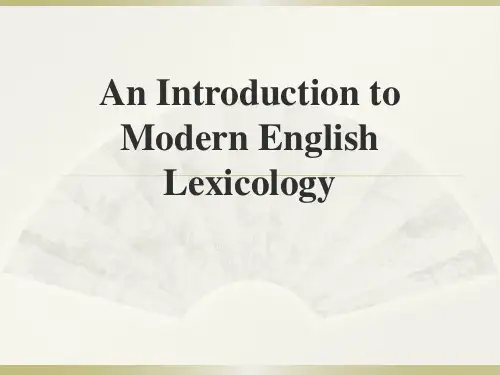
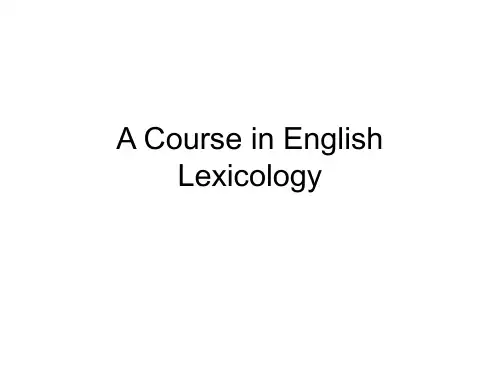
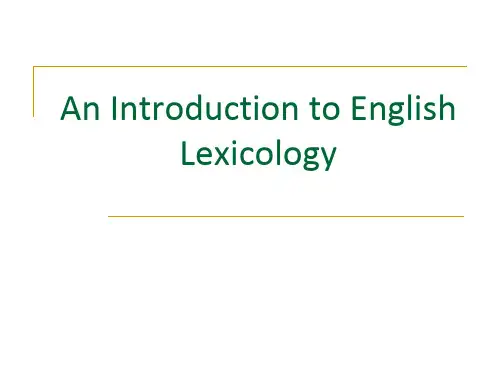
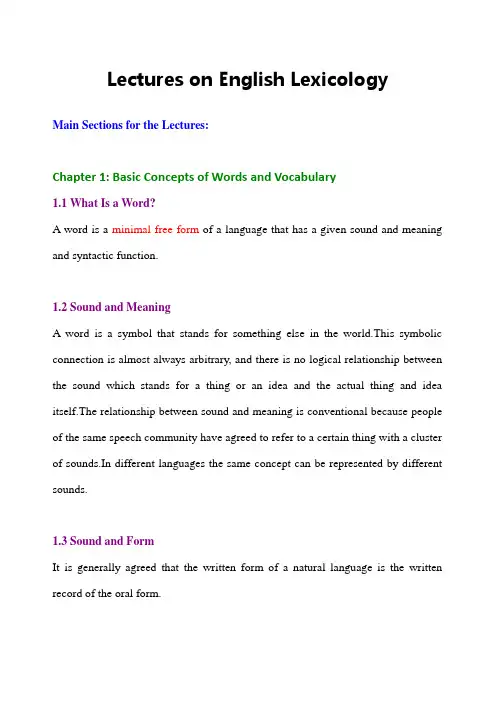
Lectures on English LexicologyMain Sections for the Lectures:Chapter 1: Basic Concepts of Words and Vocabulary1.1What Is a Word?A word is a minimal free form of a language that has a given sound and meaning and syntactic function.1.2 Sound and MeaningA word is a symbol that stands for something else in the world.This symbolic connection is almost always arbitrary, and there is no logical relationship between the sound which stands for a thing or an idea and the actual thing and idea itself.The relationship between sound and meaning is conventional because people of the same speech community have agreed to refer to a certain thing with a cluster of sounds.In different languages the same concept can be represented by different sounds.1.3 Sound and FormIt is generally agreed that the written form of a natural language is the written record of the oral form.The English alphabet was adopted from the Romans.In spite of the differences, at least eighty percent of the English words fit consistent spelling patterns.1.4 VocabularyAll the words in a language make up its vocabulary.The general estimate of the present-day English vocabulary is over one million words.1.5 Classification of Words1.5.1 Basic Word Stock and Non-basic V ocabularyBasic words have the following characteristics:1.All national character: they denote the most common things and phenomena ofthe world around us, which are indispensable to all the people who speak the language.2.Stability: as these words denote the commonest things necessary to life, they arelikely to remain unchanged.3.Productivity:as they are mostly root words or monosyllabic words, they caneach be used alone, and at the same time can form new words with other roots and affixes4.Polysemy:words of this kind often possess more than one meaning becausemost of them have undergone semantic changes in the course of use and become polysemous.5.Collocability: most of these words enter quite a number of set expressions,idiomatic usages, proverbial sayings.“All national character” is the most important of all features that may differentiate words of common use from all others.Non-basic words include the following:1.Terminology(术语): technical terms used in particular disciplines andacademic areas.2.Jargon(行话): the specialized vocabularies by which members of particular arts,sciences, trades and professions communicate among themselves.3.Slang(俚语)4.Argot(黑话)5.Dialectal words(方言词语)6.Archaisms(古语)7.Neologisms(新词)1.5.2 Content Words and Functional WordsContent words denote clear notions and thus are known as notional words(实义词).They include nouns, verbs, adjectives, adverbs and numerals, which denoteobjects, phenomena, action, quality, state, degree, quantity, etc.Functional words do not have notions of their own.They are also called empty words.The chief function of these words is to express the relation between notions, the relation between words as well as between sentences.They are known as form words.Prepositions, conjunctions, auxiliaries and articles belong to this category.Content words are numerous and the number is ever growing whereas the functional words which make up a small number of vocabulary, remain stable.However, functional words do far more work of expression in English on average than content words.1.5.3 Native Words and Borrowed WordsNative words: words brought to Britain in the 5th century by the Germanic tribes: the Angles, the Saxons, and Jutes, thus known as Anglo-Saxon words.Words of Anglo-Saxon origin are small in number, amounting to roughly 50,000 to 60,000, but they form the mainstream of the basic word stock and stand at the core of the language.Native words have two other features:1.Neutral in style: since native words denote the commonest things in humansociety, they are used by all people, in all places, on all occasions, and at alltimes.Stylistically, native words are neither formal nor informal whereas the words borrowed from French or Latin are literary and learned, thus appropriate in formal style.Frequent in use: Native words are most frequently used in everyday speech and writing.The percentage of native words in use runs usually as high as 70 to 90 percent.Borrowed word: words taken over from foreign languages are known as borrowed words or loan words or borrowings in simple terms.It is estimated that English borrowings constitute 80 percent of the modern English vocabulary.The loan words can be classified into four classes:1.Denizens(同化词)are words borrowed early in the past and now are wellassimilated into the English language. eg: pork----porc(F) cup---cuppa(L)2.Aliens(非同化词)are borrowed words which have retained their originalpronunciation and spelling. eg: bazzar (per) intermesso( IT)3.Translation loans(译借词)4.Semantic loans(语义借词)Questions and Tasks on P20: 1—6Chapter 2: The Development of the English VocabularyThe English language is not the language of the early inhabitants of the British Isles.A Historical Overview of the English vocabularyThe first peoples known to inhabit the land were Celts.Their languages were dialects of still another branch of the Indo-European language family—Celtic(克尔特语).The second major language known in England was the Latin of the Roman Legions.In 55-54 B.C., the Romans invaded the British Isles and were to occupy the land until about 410.When the Roman empire began to crumble, the Germanic tribes came in.they are Angles, Saxons, and Jutes.2.2.1 Old English (450—1150)The Germanic tribes took permanent control of the land, which was to be called England (the land of Angles).Their language, historically known as Anglo-Saxon, dominated and almost totally blotted out the Celtic.People generally refer to Anglo-Saxon as Old English.Old English has a vocabulary of about 50,000 to 60,000 words.It was a highly inflected language just like modern German.2.2.2 Middle English (1150--1500)Old English began to undergo a great change when the Normans invaded Englandfrom France in 1066.the Norman Conquest started a continual flow of French words into English.Between 1250 and 1500 about 9,000 words of French origin poured into English.75 percent of them are still in use today.2.2.3 Modern English (1500—up to now)Modern English began with the establishment of printing in England.In the early period of Modern English, Europe saw a new upsurge of learning ancient Greek and Roman classics.This is known in history as the Renaissance.In the mid-seventeenth century, England experienced the Bourgeois Revolution followed by the Industrial Revolution and rose to be a great economic power.Although borrowing remained an important channel of vocabulary expansion, yet more words are created by means of word-formation.Growth of Present-day English VocabularyGenerally, there are three main sources of new words: the rapid development of modern science and technology; social, economic and political changes; the influence of other cultures and languages.Modes of Vocabulary DevelopmentModern English vocabulary develops through three channels: creation, semanticchange, borrowing.1.Creation refers to the formation of new words by using the existing materials,namely roots, affixes and other elements.In modern times, creation is the most important way of vocabulary expansion.2.Semantic change means an old form which takes on a new meaning to meet thenew need.3.Borrowing has played a vital role in the development of vocabulary, particularlyin earlier times.Questions and Tasks on P33: 3, 4, 10Chapter 3: Word Formation IThough borrowing has been playing an active role in the expansion of vocabulary, vocabulary is largely enriched on an internal basis.boys boy+schecking check+ingchairman chair+manMorphemes(词素)the smallest meaningful unit of language Morpheme is the smallest unit of language in terms of relationship between expression and content, a unit that cannot be divided into further smaller unitswithout destroying or drastically altering the meaning, whether it is lexical or grammatical, e.g. boys---boy+-s indicates pluralitychecking---check+-ingdisappointment词是由一个或一个以上的词素构成的。
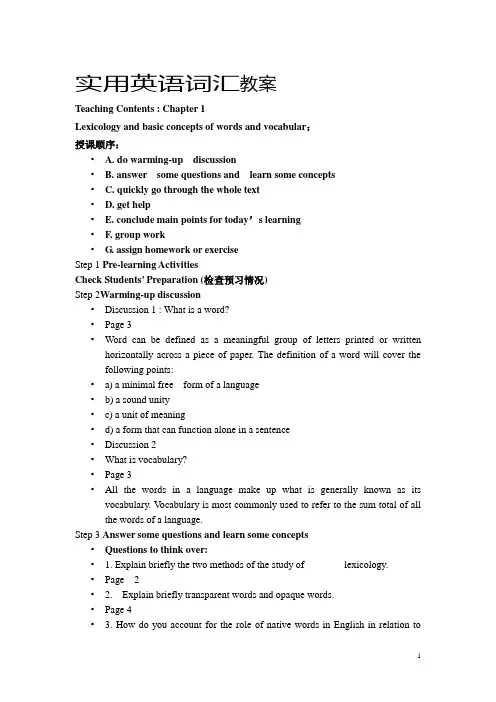
实用英语词汇教案Teaching Contents : Chapter 1Lexicology and basic concepts of words and vocabular:授课顺序:• A. do warming-up discussion• B. answer some questions and learn some concepts• C. quickly go through the whole text• D. get help• E. conclude main points for today’s learning• F. group work•G. assign homework or exerciseStep 1 Pre-learning ActivitiesCheck Students’ Preparation (检查预习情况)Step 2Warming-up discussion•Discussion 1 : What is a word?•Page 3•Word can be defined as a meaningful group of letters printed or written horizontally across a piece of paper. The definition of a word will cover the following points:•a) a minimal free form of a language•b) a sound unity•c) a unit of meaning•d) a form that can function alone in a sentence•Discussion 2•What is vocabulary?•Page 3•All the words in a language make up what is generally known as its vocabulary. V ocabulary is most commonly used to refer to the sum total of all the words of a language.Step 3 Answer some questions and learn some concepts•Questions to think over:• 1. Explain briefly the two methods of the study of lexicology.•Page 2• 2. Explain briefly transparent words and opaque words.•Page 4• 3. How do you account for the role of native words in English in relation toloan-words?•page 4 and page 133•Questions to think over:• 4. What are the classifications of words?(如何分类单词)•Page 3-4•1) full words and form words•2) popular word and learned word•3) abstract word and concrete word•4) transparent word and opaque words•5) polysemic word and monosemic word•6) native word and loan word•Concepts to learn:•Lexicology Page 1•Lexicology, as the science of words, is a branch of linguistics, inquiring into the origins and meanings of words. English lexicology aims at investigating and studying the morphological structures of English words and word equivalents, their semantic structures, relations, historical development, formation, and usages.• 2. word•(We learned just now!)• 3. vocabulary•(We also learned just now!)Step 4 Go through the whole text• 1.1 The definition of lexicology• 1.1.1 The domains of English lexicology•First…Secondly…•Thirdly…Lastly…• 1.1.2 Methods of study of lexicology• 1.2 The definition of word• 1.3 The definition of vocabulary• 1.4 Classification of wordsStep 5Helping time for solving problems.Put up your hand and let me know if you still don’t understand the text. I will come to help !!Step 6 Conclude main points for today’s learning•Main points for today• 1. the definition of English lexicology•Page 1• 2. the domains of English lexicology•Page 1• 3. methods of study of lexicology•Page 2• 4. the definition of word•Page 35. the definition of vocabulary•Page 3• 6. Classification of words•Page 3---4Step 7Group work•Discussing, writing and speaking :•Work in groups of threes or fours and think over and write on the topic Why Should a Chinese Student of English Study English Lexicology? When the group is ready, please choose one student to represent the group to make a presentation in front of the class.(先进行小组讨论,然后选一位代表来到台前陈述小组的想法和讨论结果。
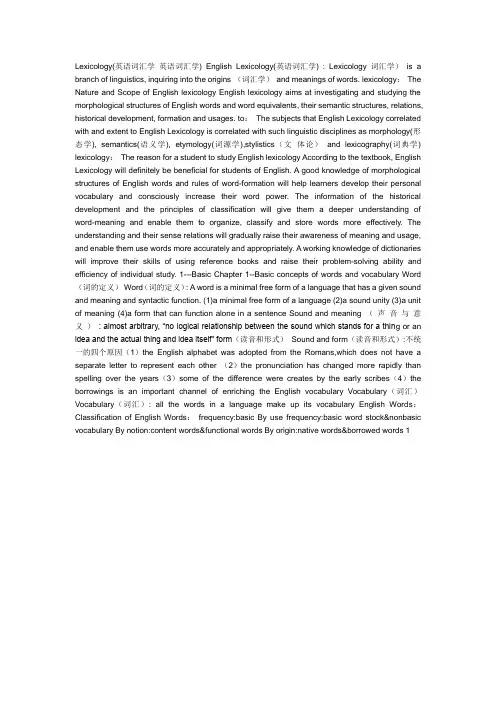
Lexicology(英语词汇学英语词汇学) English Lexicology(英语词汇学) : Lexicology 词汇学)is a branch of linguistics, inquiring into the origins (词汇学)and meanings of words. lexicology:The Nature and Scope of English lexicology English lexicology aims at investigating and studying the morphological structures of English words and word equivalents, their semantic structures, relations, historical development, formation and usages. to:The subjects that English Lexicology correlated with and extent to English Lexicology is correlated with such linguistic disciplines as morphology(形态学), semantics(语义学), etymology(词源学),stylistics(文体论)and lexicography(词典学) lexicology:The reason for a student to study English lexicology According to the textbook, English Lexicology will definitely be beneficial for students of English. A good knowledge of morphological structures of English words and rules of word-formation will help learners develop their personal vocabulary and consciously increase their word power. The information of the historical development and the principles of classification will give them a deeper understanding of word-meaning and enable them to organize, classify and store words more effectively. The understanding and their sense relations will gradually raise their awareness of meaning and usage, and enable them use words more accurately and appropriately. A working knowledge of dictionaries will improve their skills of using reference books and raise their problem-solving ability and efficiency of individual study. 1---Basic Chapter 1--Basic concepts of words and vocabulary Word (词的定义)Word(词的定义): A word is a minimal free form of a language that has a given sound and meaning and syntactic function. (1)a minimal free form of a language (2)a sound unity (3)a unit of meaning (4)a form that can function alone in a sentence Sound and meaning (声音与意义): almost arbitrary, “no logical relationship between the sound which stands for a thin g or an idea and the actual thing and idea itself” form(读音和形式)Sound and form(读音和形式):不统一的四个原因(1)the English alphabet was adopted from the Romans,which does not have a separate letter to represent each other (2)the pronunciation has changed more rapidly than spelling over the years(3)some of the difference were creates by the early scribes(4)the borrowings is an important channel of enriching the English vocabulary Vocabulary(词汇)Vocabulary(词汇): all the words in a language make up its vocabulary English Words:Classification of English Words:frequency:basic By use frequency:basic word stock&nonbasic vocabulary By notion:content words&functional words By origin:native words&borrowed words 1stock(基本词汇)The basic word stock(基本词汇): is the foundation of the vocabulary accumulated over centuries and forms the common core of the language. Though it constitute a small percentage of the EV, it is the most important part of vocabulary. Stock(基本词汇的特征) The Fundamental Features of the Basic Word Stock(基本词汇的特征): 1)All-National character(全民通用性most important)2)Stability(相对稳定性)3)Productivity(多产性)4)Polysemy(多义性)5)Collocability(可搭配性)words:(1)T erminology(术语) (2)Jargon(行话)(3)slang 没有上述特征的words: (俚语)(4)Argot(暗语)(5)Dialectal words(方言) (6) Archaisms(古语)(7) Neologisms(新词语):Neologisms means newly-created words or expressions, or words that have taken on new meanings.(email) words/notional Content words/notional words 实词(cloud, run walk, never, five, frequently) and functional words/empty words 虚词(on, of, and, be, but) words/empty 虚词( ) ) Words Native Words and Borrowed Words Nati words(本族语词)Native words(本族语词): known as Anglo-Saxon words (50,000-60,000), are words brought to Britain in the 5th century by the Germanic tribes. (mainstream of the basic word-stocks).Two other features:(1)neutral in style (2)frequent in use words/Loan words 外来语词)ords(Borrowed words/Loan words (外来语词): words taken over from foreign languages.(80% of modern EV) 4 Types of loan words: 1) denizens(同化词): (shirt from skyrta(ON)) 2) aliens(非同化词/外来词):are borrowed words which have retained their original pronunciation and spelling (kowtow (CH)磕头) 3) translation loans(译借词):按其他语言方式组成英语long time no see (from China) 4) semantic loans(借义词):they are not borrowed with reference to the form,but their meanings are borrowed Chapter 2 the development of the English Vocabulary Family(印欧语系) The Indo-European Language Family(印欧语系) IndoThe Eight Groups in Indo-European Family of Languages(8 大印欧语群)The Eastern set: (1)The Balto-slavic Group(波罗的-斯拉夫语族):Russian,Bulgarian,Polish,Czech etc. (2)The Indo-Iranian Group(印度-伊朗语族):Hindi,Bengali,Persian etc. (3)The Armenian Group(亚美尼亚语族):Armenian. (4)The Albanian Group(阿尔巴尼亚语族):Albanian. The Western set: (5)The Hellenic Group(古希腊语族):Greek. (6)The Italian Group (意大利语族):Latin ,Romance languages(French,Italian,Spanish, portuguese,Romanian) etc. (7)The Celtic Group(凯尔特语族):Irish,Welsh,Breton etc. (8)The Germanic Group(日耳曼语族):Flemish,German,Dutch,Scandinavian(Norweigian, Swedish,Danish,Icelandic) etc. 2Development Vocabulary: The Three Stages of Development of the English Vocabulary: 1 Old English (450-1100) (vocabulary 50,000 to 60,000):was I high inflected language. 2 Middle English (1150-1500):retaines much fewer inflections 3 Modern English (1500-up to now): in fact more than 25% of modern E words come almost directly from classical languages. In Modern E, words endings were mostly lost with just a few expections.English has evolved from a synthetic language(Old English) to the present analytic language. Vocabulary Development(词汇的发展模式词汇的发展模式): Modes of Vocabulary Development(词汇的发展模式): 1)creation 创造新词:the formation of new words by using the existing materials,namely toots,affixes and other elements.(最重要方式) 2)semantic change 旧词新义:does not increase the number of word forms but create many more new useages of the words. 3) borrowing 借用外来词:constitute merely 6 to 7 percent of all new words Reviving words or obsolete words also contributes to the growth of English vocabulary though quite insignificant. Chapter 3 Word Formation I Morpheme(词Morpheme(词素):the smallest functioning unit in the composition of words Allomorph(词素变体) Allomorph(词素变体): is a different variant form of a morpheme,differ in phonological and spelling form, but at the same in function and meaning Morpheme(词素的分类) Type of Morpheme(词素的分类) (1)Free Morphemes(自由词素): have complete meaning in themselves and can be used as free grammatical units in sentences. A free morpheme is one that can stand by itself. (independent). (2)Bound Morpheme(粘着语素): A bound morpheme is one that cannot stand by itself. Bound Morpheme includes two types: (1) bound root(粘附词根) (2)Affix(词缀) Affixes can be put into two groups: 1)Inflectional affixes (屈折词缀):affixes attached to the end of words to indicate grammatical relationships are inflectional,thus known as inflectional morphemes. 2)Derivational affixes(派生词缀): A) prefix: A prefix comes before words. B)suffix:An adjective suffix(形容词后缀)that is added to the stem, whatever class is belongs to , the result will be an adjective. Free Morpheme =free root (自由词根)Morpheme(词素) bound Bound root derivational affix inflectional prefix suffix stem(词根和词干)Root and stem(词根和词干)The differences between root and stem: A root is the basic form of a word which cannot be further analyzed without total loss of identity. 3A stem is the surplus part after the cutting of inflectional morpheme in a word with inflectional morphemes,can be further analyzed, it sometimes could be a root. WordII(构词法) Chapter 4 Word-Formation II(构词法) 1.Affixation 词缀法(Derivation 派生法):the formation of words by adding 1.Affixation 词缀法word-formaing or derivational affixes to stem. (1)Prefixation(前缀法):It's the formation of new words by adding a prefixes to stems. 1)Negative prefixes( 否定前缀): un-,non-,in-,dis,a- ,il-,ir-,im-,etc.disobey(not obey) 2)Reversative prefixes(逆反前缀): un-,de-,dis- etc. unwrap(open) 3) Pejorative prefixes: mis (贬义前缀):mis- ,mal-, pseudoetc.misconduct(bad behaviour) 4) Prefixes of degree or size(程度前缀):arch-,extra-,hyper-,macro-,micro-,mini-,out-,over-,sub-,super-,sur-,u ltra-,under-,ect. overweight 5) Prefixes of orientation and attitude (倾向态度前缀):contra-,counter-,anti-,pro- etc.anti-nuclear 6)Locative prefixes 方位前缀)(:extra-,fore-,inter-,intra-,tele-,trans-, etc. extraordinary(more than ordinary) 7) Prefixes of time and order(时间和顺序前缀):fore-,pre-,post-,ex-,reetc. monorail(one rail) 8) Number prefixes (数字前缀):uni-,mono-, bi-,di-, tri-,multi-,poly- ,semi-,etc.bilingual(concerning two languages) 9) Miscellaneous prefixes (混杂前缀):auto-, neo-, pan-, vice-.vice-chairman(deputy chairman) (2)Suffixation (后缀法): It's the formation of a new word by adding suffixes to stems. 1)noun suffixes 2)adjective suffixes 3)Adverb suffixes 4)verb suffixes pounding composition)pounding 复合法(also called composition)Compounding: is the formation of new words by joining two or more stems Compounds are written in three ways: solid 连写(airmail),hyphenated 带连字符(air-conditioning)and open 分开写(air force, air raid) Formation of compounds(复合词的形式)(1)noun compounds :e.g. : air + plane = airplane,flower + pot = flower pot (2)adjective compounds :e.g. acid + head = acid-head (3)verb compounds :e.g. house + keep = housekeep 3.Conversion 转类法 3.Conversion 转类法Conversion: is the formation of new words by converting words of one class to another class. 功能转换,(又叫零派生.functional shift/zero-derivation)44.Blending 拼缀法4.Blending 拼缀法Ble Blending : is the formation of new words by combining parts of two words or a word plus a part of another word. e.g: motor + hotel = motel, smoke + fog = smog, formula + translation = FORTRAN5.Clipping 5.Clipping 截短法Clipping:is to shorten a longer word by cutting a part off the original and using what remains instead.e.g. plane from airplane, phone from telephone. 四种形式:1).Front clippings 删节前面(phone from telephone) 2).Back clippings 删节后面(dorm from dormitory) 3).Front and back clippings 前后删节(flu from influenza) 4).Phrase clippings 短语删节(pop from popular music)6.Acronymy 6.Acronymy 首字母缩写法Acronymy:is the process of forming new words by joining the initial letters of names of social and political organizations or special noun phrases and technical terms. (1)Initialism (首字母缩写词法)initialisms are words pronounced letter : by letter. e.g.: BBC(for British Broadcasting corporation) (2)Acronym (首字母拼音法):Acronyms are words formed from initial letters but pronounced as a normal word. E.g.:TEFL(teaching English as a foreign language)7.Back-formation(逆生法,逆构词)7.Back-formation(逆生法,逆构词)Back Back-formation is considered to be the opposite process of suffi xation. It‟s the method of creating words by removing the supposed suffixes. (greed from greedy)8.Words Name(专有名词转成法): 8.Words From Proper Name(专有名词转成法): Names of people, places, book, and tradenames (e.g.: sir watt siemens(人名) -- watt(瓦特,电功率单位)Chapter 5 Word Meaning Meaning” The meanings of “Meaning” (“意义”的意义) Reference(所指):It is the relationship between language and the word. It Reference is the arbitrary and conventional. It is a kind of abstraction, yet with the help of context, it can refer to something specific. Concept (概念):which is beyond language, is the result of human cognition(认识),reflecting the objective world in the human mind. Sense(意义):It denotes the relationship inside the language. …The sense Sense of an expression is its place in a system of semantic relationships with 5other expressions in the language.‟ Motivation(理据):It accounts for the connection between the linguistic Motivation symbol and its meaning. 1) Onomatopoeic motivation(拟声理据):words whose sounds suggest their meaning, for these words were creates by imitating the natural sounds or noises. Knowing the sounds of the words means understanding the meaning. E.g.: bang, ping-pong, ha ha. 2)Morphological motivation (形态理据):multi-morphemic words and the meaning of many are the sum total of the morphemes combines. E.g.: airmail, miniskirt .例外:black market, ect.3)Semantic motivation (词义理据)refers to the mental associations :suggested by the conceptual meaning of a word. It explains the connection between the literal sense and figurative sense of the word. E.g:the foot of the mountain(foot) 4)Etymological motivation (词源理据):the history of the word explains the meaning of the word. E.g:pen-feather meaning(词义的类别) Types of meaning(词义的类别) 1.Grammatical Meaning(语法意义):indicates the grammatical concept or relationships (becomes important only in actual context) 2.Lexical Meaning (词汇意义)(Lexical meaning and grammatical meaning make up the word-meaning) Lexical meaning has 2 components 内容: Conceptual meaning(概念意义) and associative meaning(关联意义) 1)Conceptual meaning(概念意义): also known as denotative meaning(外延意义) is the meaning given in the dictionary and forms the core of word-meaning. 2)Associative meaning(关联意义):is the secondary meaning supplemented to the conceptual meaning. [4types: (1)Connotative(内涵意义):the overtones or associations suggested by the conceptual meaning, traditionally known as connotations.(例如“母亲”经常与“爱” “关心” “温柔”联系起来) (2)Stylistic (文体意义)many words have stylistic features, which make :them appropriate for different contexts. (3)Affective (感情意义):indicates the speaker‟s attitude towards the person or thing in question.这种情感价值观分两类:褒义和贬义appreciative & pejorative (4)Collocative(搭配意义):is the part of the word-meaning suggested by the words before or after the word in discussion.] --Sense Chapter 6 --Sense relation and semantic field (语义关系和语义场)Polysemy(多义关系)Polysemy Two approached to polysemy(多义关系的两种研究方法): 61.diachronic approach(历时方法) :from the diachronic point of view, polysemy is assumed to be the result of growth and development of the semantic structure of one and same word. First meaning is the primary meaning , the later meanings are called derived meanings.2. synchronic approach (共时方法) : synchronically, polysemy is viewed as the coexistence of various meanings of the same word in a certain historical period of time.基本意义是central meaning , 次要意义是derived meaning. Two processes of development(词义的两种发展类型): 1. radiation(辐射型):is a semantic process in which the primary meaning stands at the centre and the secondary meanings proceed out of it in every direction like rayes. (e.g: face, neck) 2. concatenation(连锁型):is the semantic process in which the meaning of a word move gradually away from its first sense by successive shifts until there is not a sign of connection between the sense that is finally developed and that which the term had at the beginning.(e.g:treacle)3. In radiation, each of the derived meaning is directly connected to the primary meaning. In concatenation, each of the later meaning is related only to the preceding one like chains. Though the latest sense can be traced back to the original, there is no direct connection in between.4. They are closely related, being different stages of the development leading to polysemy. Generally, radiation precedes concatenation. In many cases, the two processes work together, complementing each other. Homonymy (同形同音异义关系):words different in meaning but either identical both in sound and spelling or identical only in sound or spelling. homonyms(同音同形异义关系的类别) Types of homonyms(同音同形异义关系的类别) 1)Perfect homonyms(完全同音同形异义词):words identical both in sound and spelling, but different in meaning. 2)Homographs (同形异义词):words identical only in spelling, but different in sound and meaning.(最多最常见) 3)Homophones(同音异义词):words identical only in sound but different in spelling and meaning. 同形同音异义词的来源) Origins of homonyms (同形同音异义词的来源) 1)change in sound and spelling :(eare-ear, lang-long, langian-long) 2)borrowing (feria-fair, beallu-ball, baller-ball ) 3)Shortening(缩略): (ad-advertisement,) The differentiation of Homonyms from Polysemes(同音同形异义词和多义词的区别):1)The fundamental difference : Homonymy refers to different words which happen to share the same form and polysemy are the one and same word which has several distinguishable meanings. 72)One important criterion is to see their etymology(词源):Homonymys are from different sources. Polysemant is from the same source. 3)The second principle consideration is semantic relatedness(语义关联): The various meanings of polysemant are correlated and connected to one central meaning. Meanings of different homonymys have nothing to do with one another. In dictionaries, a polysemant has its meaning all listed under one headword whereas homonyms are listed as separate entries. Rhetoric features of homonyms(同形同音异义词的修辞特色):As homonyms are identical in sound or spelling, particularly homophones, they are often employed to create puns for desired effect of, say, humor, sarcasm or ridicule. Synonymy (同义关系): one of two or more words in the English language which have the same or very nearly the same essential meaning . Types of Synonymy(同义词的类别) : (1)Absolute synonyms(完全同义词):also known as complete synonyms are words which are identical in meaning in all aspects, i.e. both in grammatical meaning and lexical meaning, including conceptual and associative meanings.[ Absolute synonyms are restricted to highly specialized vocabulary in lexicology. ] (2)relative synonyms(相对同义词):also called near-synonyms are similar or nearly the same in denotation, but embrace different shades of meaning or different degrees of a given quality.(e.g: change/alter/vary, stagger/reel/totter, strange/odd/queer, idle/lazy/indolent) Sources of synonyms(同义词的来源) : 1)Borrowing (借词)最重要的来源(room-chamber, foe-enemy, help-aid, :leave-depart, wise-sage, buy-purchase) 2)Dialects and regional English (方言和地区英语)3)Figurative and euphemistic use of words (单词的修饰和委婉用法):occupation/profession-walk of life, dreamer--star-gazer, drunk-elevated, lie-distort of fact.4)Coincidence with idiomatic expressions(与习惯表达一致):win-gain the upper hand, decide-make up one‟s mind, finish-get through, hesitate-be in two minds, help-lend one a hand. Discrimination of Synonyms (1)difference in denotation 外延不同. Synonyms may differ in the range and intensity of meaning.(rich-wealthy, work-toil, want-wish-desire) (2)difference in connotation 内涵不同 . By connotation we mean the stylistic and emotive colouring of words. Some words share the same denotation but differ in their stylistic appropriateness. ( 借词:answer-respond, storm-tempest, wood-forest, handy-manual, unlike-dissimilar, homely-domestic, fleshy-carnal. 中性词:8policeman-constable-bobby-cop, ask-beg-request. 古语词、诗歌:ire/anger, bliss-happiness, forlorn-distresses, dire-dreadful, list-listen, enow-enough, save-expect, mere-lake ) (3)difference in application. Many words are synonymous in meaning but difference in usage in simple terms. They form different collocations and fit into difference sentence patterns. (allow sb. to do sth.- let sb. do sth. / answer the letter-reply to the letter) Antonymy (反义关系) :it is concerned with semantic opposition. Antonyms can be defined as words which are opposite in meaning. Types of Antonyms: 1)contradictory terms ( 矛盾反义词): these antonyms truly represent oppositeness of meaning. 特点:①The assertion of one is the denial of the other. ②Such antonyms are non-gradable. They cannot be used in comparative degrees and do not allow adverbs of intensity like “very” to qualify them . (e.g: single/married) 2)contrary terms(对立反义词): antonyms of this type are best viewed in terms of a scale running between two poles or extremes.(e.g: old/young, rich/young, big/small) The two opposites are gradable and one exists in comparison with the other.3)relative terms (关系反义词)this type consists of relational opposites. :(parent/child, husband/wife, employee/employer, sell/buy, receive-give)antonyms(反义关系的特点): Some of the characteristics of antonyms(反义关系的特点): 1)antonyms are classified on the basis of semantic opposition(语义对立) 2)a word which has more than one meaning can have more than one antonym 3)antonyms differ in semantic inclusion(语义内涵)4)contrary terms are gradable antonyms,differing in degree of intensity, so each has its own corresponding opposite.(hot/warm: hot-cold/warm-cool) antonyms(反义词的使用)The use of antonyms(反义词的使用)1)Antonyms are helpful and valuable in defining the meaning of words. 2)To express economically the opposite of a particular thought for the sake of contrast.(e.g :now or never, rain or shine, friend or foe 敌友,weal and woe 哀乐) 3)To form antithesis(对比法) to achieve emphasis by putting contrasting idea together. (proverbs and sayings: easy come , easy go./ more haste, less speed.) Hyponymy(上下义关系): Hyponymy deals with the relationship of semantic Hyponymy inclusion. The meaning of a more specific word is included in that of another more general word. For example, a cat is hyponym of animal Superordinate and Subordinate (上义词和下义词):use subordinates which are concrete and precise ,presenting a vivid verbal picture before the reader. Superordinates which convey only a general and vague idea. 9Field(语义场) Semantic Field(语义场) Viewing the total meaning in this way is the basis of field theory. e.g.(apple, pear, peach, date, mango, orange, lemon, etc. make up the semantic field of …fruits‟) The semantic field of the same concept may not have the same members in different language. e.g.(aunt in English, may means “父亲的姐姐,妈妈的姐姐,父亲哥哥的妻子” in Chinese.(122) Chapter 7 Changes in Word Meaning 词义的演变Vocabulary is the most unstable element of a language as it is undergoing constant changes both in form and content. Comparatively the content is even more unstable than the form. Changes 词义变化的种类) Types of Changes (词义变化的种类) 1.Extension generalization( 1.Extension /generalization( 词义的扩大): is the name given to the widening of meaning which some words undergo. It is a process by which originally had a specialized meaning has now become generalized.(e.g: manuscript, fabulous, picture, mill, journal, bonfire, butcher, companion) 2.Narrowing specialization( 词义的缩小) Narrowing/ 2.Narrowing/ specialization( 词义的缩小) :is the opposite of widening meaning. It is a process by which a word of wide meaning acquires a narrower or specialized sense. In other words, a word which used to have a more general sense becomes restricted in its application and conveys a special meaning in present-day English.(e.g: deer, corn, garage, liquor, meat, disease, poison, wife, accident, girl). [ when a common word is turned into a proper noun, the meaning is narrowed accordingly. ] 3.Elevation amelioration( 升华) 3.Elevation /amelioration( 词义的升华):refers to the process by which words rise from humble(粗陋的)beginnings to positions of importance. [nice, marshal, constable, angel, knight, earl, governor, fond, minister, chamberlain ] 4.Degradation pejoration(词义的降格Degrada 降格) 4.Degradation / pejoration(词义的降格):A process whereby words of good origin fall into ill reputation or non-affective words come to used in derogatory(贬损的)sense.[boor, churl, wench, hussy, villain, silly, knave, lewd, criticize, lust ] 5.Transfer 词义的转移) Transfer( 5.Transfer(词义的转移): Words which were used to designate 指明one thing but later changed to mean something else have experienced the process of semantic transfer. Semantic Change(词义变化的原因) Causes of Semantic Change(词义变化的原因) 1.Extra Extrafactors(词义演变的语言外部因素) 1.Extra-linguistic factors(词义演变的语言外部因素): 1) Historical reason( 历史原因) :Increased scientific knowledge and 10discovery, objects, institutions, ideas change in the course of time. E.g: pen, car, computer. 2 )Class reason(阶级原因):The attitude of classes have also made inroads into lexical meaning in the case of elevation or degradation. 3) Psychological reason(心理原因):the associated transfer of meaning and euphemistic use of words are often due to psychological factors. Such slow, humble and despised occupations take more appealing names is all due to psychological reasons. 2.Linguistic factors(语言内部原因):the change of meaning may be caused 2.Linguistic factors(语言内部原因)by internal factors with in the language system. 1)shorting 缩略:gold-gold medal, gas-coal gas, bulb-light bulb, private-private soldier 2)borrowing 借用:deer-animal-beast 3)analogy 类推: 词义和语境Chapter 8 Meaning and Context 词义和语境Context in its traditional sense refers to the lexical items that precede or follow a given word. Modern linguists have broadened its scope to include both linguistic and extra-linguistic contexts. context(语境的种类)Two types of context(语境的种类)Extracontext/ Nonsituation(非语言语境):In 1. Extra-linguistic context/ Non-linguistic situation(非语言语境)a broad sense, context includes the physical situation as well, which embraces the people, time, place, and even the whole cultural background. (look out, weekend, landlord ) 2.Linguistic context/ grammatical context context(语言语境):In a narrow sense, Linguistic context/ it refers to the words, clauses, sentences in which a word appears. It may cover a paragraph, a whole chapter and even the entire book.分为两类:1) Lexical context(词汇语境):It refers to the word that occurs together with the word in question. (e.g: paper, do) 2) Grammatical context (语法语境)It refers the situation when the meaning :of a word may be influenced by the structure in which it occurs. (e.g: become) context(语境的作用) The role of context(语境的作用) 1.Eliminat Elimination ambiguity 消除歧义) 1.Elimination of ambiguity(消除歧义) 1)Ambiguity due to polysemy or homonymy. 2)Grammatical structure can also lead to ambiguity 如何消除歧义?——①extend the original sentence ②alter the context a little 2.Indicat Indication referents 限定所指) 2.Indication of referents(限定所指) 如何限定所指?——①with clear context ②with adequate verbal context 3.Provision word提供线索以猜测词义) 3.Provision of clues for inferring word-meaning (提供线索以猜测词义) 111)definition 2)explanation 3)example 4)synonymy 5)antonymy 6)hyponymy(上下义关系)7)relevant details 8)word structure English Chapter 9 English Idioms 英语习语dioms(习语的定义)Idioms(习语的定义): are expressions that are not readily understandable from their literal meaning of individual elements. In a broad sense, idiom may include colloquialisms (俗语)Catchphrases , (标语),slang expressions (俚语),proverbs(谚语),etc. They form an important part of the English vocabulary. Idioms(英语习语的特点)Characteristics of Idioms(英语习语的特点)1.Semantic 语意的整体性)1.Semantic unity (语意的整体性)words in the idiom they have lost their :individual identity. Their meanings are not often recognizable in the meaning of the whole idiom. The semantic unity of idioms is also reflected in the illogical relationship between the literal meaning of each of the idiom. 2.Structural stability(结构的稳定性) 2.Structural stability(结构的稳定性):the structure of an idiom is to a large extent un changeable. 1) the constituents of idioms cannot be replaced 2) the word order cannot be inverted or changed 3) the constituents of idioms cannot be deleted or added to, not even an article. 4) many idioms are grammatically unchangeable The fixity of idiom depends on the idiomaticity.习语性表达习惯Idioms(英语习语的分类)Classification of Idioms(英语习语的分类) 1. idioms nominal in nature 名词性习语(white elephant 累赘物) 2 .idioms adjectival in nature 形容词性习语(as poor as a church mouse)3 .idioms verbal in nature 动词性习语(look into)4 .idioms adverbial in nature 副词性习语(tooth and nail 拼命)5 .sentence idioms 句式习语(never do things by halves)idioms(习语的使用)Use of idioms 1.Stylistic features(文体色彩):Stylistic features(文体色彩)1)colloquialisms(俗语)2)slang (俚语)3)literary expressions(书面表达)12The same idiom may show stylistic differences when it is assigned(指派)different meanings.2.Rhetorical features(修辞色彩) 2.Rhetorical features(修辞色彩) 1) phonetic manipulation (语音处理):(1)alliteration 头韵法(2)rhyme 尾韵法2)lexical manipulation(词法处理)(1)reiteration(duplication of synonyms)同义词并举[scream and shout] (2)repetition 重复[out and out] (3)juxtaposition (of antonyms) 反义词并置[here and there]3.figures speech(修辞格)3.figures of speech(修辞格)(1)simile 明喻(2)metaphor 暗喻(3)metonymy 换喻/以名词代动作:live by one‟s pen (4)synecdoche 提喻/以部分代整体:earn one‟s bread (5)Personification 拟人法(6)Euphemism 委婉语:kick the bucket(die) (7)hyperbole 夸张:a world of trouble idioms(习语的变异形式) Variations of idioms(习语的变异形式): 1.addition 增加2.deletion 删除 3.replacement 替换4.position-shifting 位置转移5.dismembering 分解Chapter 10 English Dictionaries 英语字典Dictionary: Dictionary presents in alphabetical order the words of English, with information as to their spelling ,pronunciation, meaning, usage , rules and grammar, and in some, their etymology(语源). dictionaries(词典的种类) Types of dictionaries(词典的种类): 1.Monolingual dictionaries(单语词典和双语词典):最早的词1.Monolingual & bilingual dictionaries (单语词典和双语词典)最早的词:典都是双语的(1).Monolingual dictionary: is written in one language (LDCE, CCELD). The headword or entries are defined and illustrated in the same language. (2).Bilingual dictionary: involve two languages (A New English-Chinese D, A Chinese-English D) 2.Linguistic dictionaries(语文词典与百科词典)2.Linguistic and Encyclopedic dictionaries(语文词典与百科词典)(1)Linguistic dictionary: aim at defining words and explaining their usages in the language (spelling, pronunciation, meaning, grammatical, 13。
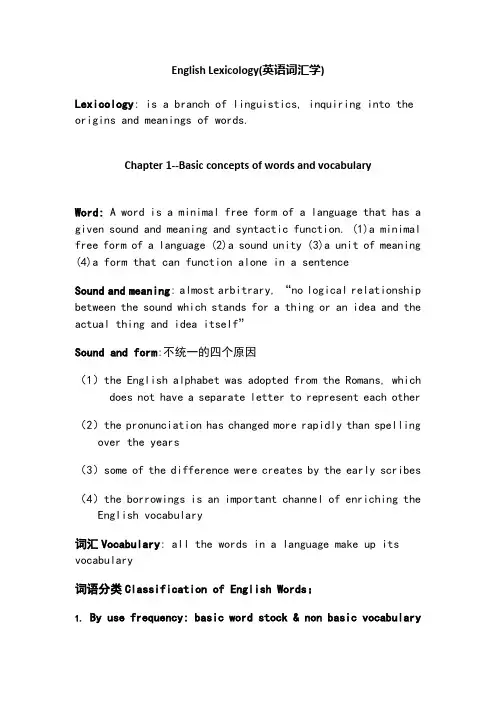
English Lexicology(英语词汇学)Lexicology: is a branch of linguistics, inquiring into the origins and meanings of words.Chapter 1--Basic concepts of words and vocabularyWord: A word is a minimal free form of a language that has a given sound and meaning and syntactic function. (1)a minimal free form of a language (2)a sound unity (3)a unit of meaning (4)a form that can function alone in a sentenceSound and meaning: almost arbitrary, “no logical relationship between the sound which stands for a thing or an idea and the actual thing and idea itself”Sound and form:不统一的四个原因(1)the English alphabet was adopted from the Romans, which does not have a separate letter to represent each other(2)the pronunciation has changed more rapidly than spelling over the years(3)some of the difference were creates by the early scribes(4)the borrowings is an important channel of enriching the English vocabulary词汇Vocabulary: all the words in a language make up its vocabulary词语分类Classification of English Words:1.By use frequency: basic word stock & non basic vocabulary基本词汇的特征:1)All-National character(全民通用性most important)2)Stability3)Productivity(多产性) 4)Polysemy(多义性)5)Collocability(可搭配性)没有上述特征的词:(1)Terminology(术语) (2)Jargon(行话)(3)slang(俚语)(4)Argot(暗语)(5)Dialectal words (6)Archaisms(古语) (7) Neologisms(新词语):Neologisms2.By notion: content words实词 & functional words虚词3.By origin: native words & borrowed wordsNative words(本族语词): Two other features:(1)neutral in style (2)frequent in useBorrowed words/Loan words: words taken over from foreign languages.(80% of modern EV)1) denizens(同化词,融入英语): (shirt from skyrta(ON))2) aliens(非同化词/外来词,可以看出源头): kowtow3) translation loans(译借词):按其他语言方式组成英语long time no see / tofu4) semantic loans(借义词):they are not borrowed withreference to the form,but their meanings are borrowed pioneer本指开拓者,先引申为先锋。
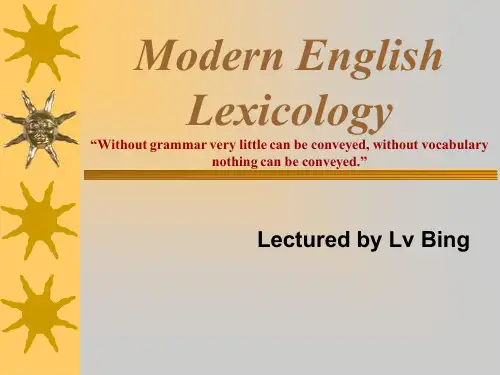
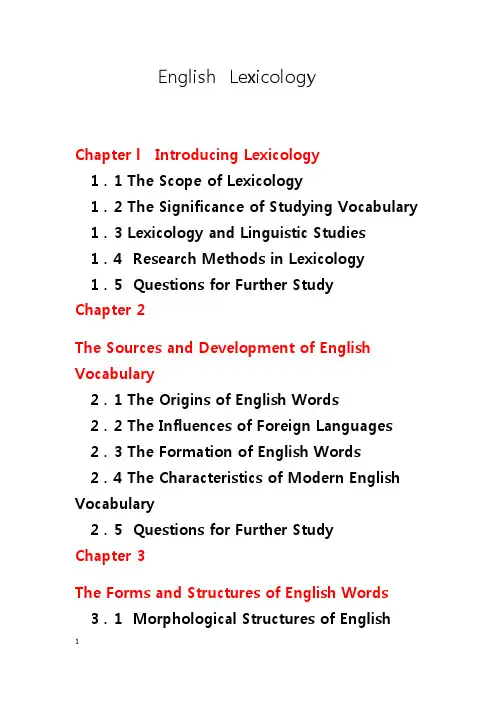
English LexicologyChapter l Introducing Lexicology1.1 The Scope of Lexicology1.2 The Significance of Studying Vocabulary 1.3 Lexicology and Linguistic Studies1.4 Research Methods in Lexicology1.5 Questions for Further StudyChapter 2The Sources and Development of English Vocabulary2.1 The Origins of English Words2.2 The Influences of Foreign Languages2.3 The Formation of English Words2.4 The Characteristics of Modern English Vocabulary2.5 Questions for Further StudyChapter 3The Forms and Structures of English Words3.1 Morphological Structures of English Words----形态学结构3.2 Morphemes----词素3.3 Roots----词根3.4 Questions for Further Study Chapter 4Word Formation Via Affixation –词缀法4.1 Lexical Prefixes 前缀4.2 Grammatical Prefixes4.3 Lexical Suffixes 后缀4.4 Grammatical Suffixes4.5 Questions for Further StudyChapter 5Word Formation Via Compounding—复合法5.1 Three Forms of Compounds5.2 Structures of Compounds5.3 Functions of Compounds5.4 Characteristics of Compounds5.5 Compound Nouns5.6 Compound Adjectives5.7 Phrasal Compounds5-8 Questions for Further StudyChapter 6Word Formation Via Other Methods6.1 Blending6.2 Conversion6.3 Borrowing6.4 Clipping --裁剪6.5 Acronymy首字母缩略法 and Initialism首字母缩略词6.6 Questions for Further StudyChapter 7 Sense Relations—语义关系7.1 Types of Meaning7.2 Sense Relations7.3 Polysemy—一词多义7.4 Homonymy---同音异义7.5 Questions for Further StudyChapter 8 Figurative Language—语言特色8.1 Simile ---明喻8.2 Metaphor---暗喻8.3 Personification---拟人8.4 Dehumanization—非人性化8.5 Hyperbole---夸张8.6 Allusion---典故暗示8.7 Paradox----悖论8.8 0nomatopoeia ---拟声词8.9 Questions for Further StudyChapter 9Language Variation and Word Choice9.1 Speakers./Writers.Choice of Words 9.2 Word Choice for Formal English9.3 Words to Avoid in Formal English9.4 Questions for Further StudyChapter l0 Collocations----搭配10.1 Noun Collocations1 0.2 Verb Collocations1 0.3 Adjective Collocations1 0.4 Adverb Collocations1 0.5 Preposition Collocations1 0.6 Conjunction Collocations1 0.7 Questions for Further StudyChapter 11Dictionaries and Vocabulary Learning11.l Types of Dictionaries11.2 Information in Dictionaries11.3 Monolingual and Bilingual Dictionaries 11.4 Principles of Selecting a Dictionary 11.5 Questions for Further StudyChapter l2English Vocabulary Learning Strategies1 2.1 Classifications of Vocabulary Learning Strategies1 2.2 Suggested Methods in Learning Vocabulary1 2.3 Questions for Further Study。
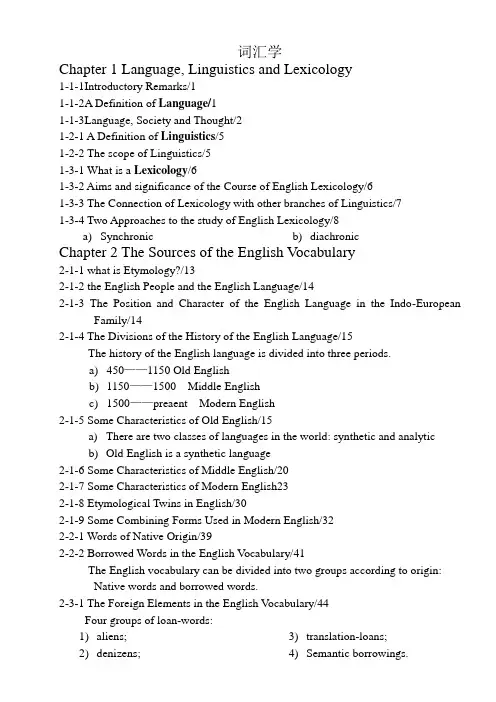
词汇学Chapter 1 Language, Linguistics and Lexicology1-1-1Introductory Remarks/11-1-2A Definition of Language/11-1-3Language, Society and Thought/21-2-1 A Definition of Linguistics/51-2-2 The scope of Linguistics/51-3-1 What is a Lexicology/61-3-2 Aims and significance of the Course of English Lexicology/61-3-3 The Connection of Lexicology with other branches of Linguistics/71-3-4 Two Approaches to the study of English Lexicology/8a)Synchronic b)diachronicChapter 2 The Sources of the English V ocabulary2-1-1 what is Etymology?/132-1-2 the English People and the English Language/142-1-3 The Position and Character of the English Language in the Indo-European Family/142-1-4 The Divisions of the History of the English Language/15The history of the English language is divided into three periods.a)450——1150 Old Englishb)1150——1500 Middle Englishc)1500——preaent Modern English2-1-5 Some Characteristics of Old English/15a)There are two classes of languages in the world: synthetic and analyticb)Old English is a synthetic language2-1-6 Some Characteristics of Middle English/202-1-7 Some Characteristics of Modern English232-1-8 Etymological Twins in English/302-1-9 Some Combining Forms Used in Modern English/322-2-1 Words of Native Origin/392-2-2 Borrowed Words in the English V ocabulary/41The English vocabulary can be divided into two groups according to origin:Native words and borrowed words.2-3-1 The Foreign Elements in the English V ocabulary/44Four groups of loan-words:1)aliens;2)denizens; 3)translation-loans;4)Semantic borrowings.2-3-2 The Scandinavian Element in the English V ocabulary/44Most of the Scandinavian borrowings belong to the colloquial language.2-3-3 The French Element in the English V ocabulary/462-3-4 The Latin Element in the English V ocabulary/492-3-5 The Greek Element in the English V ocabulary/522-3-6 The influence of the Classical Elements upon the English V ocabulary/532-3-7 Other Foreign Elements in the English V ocabulary/552-3-8 The Interrelation between the Native and Foreign Elements in the English V ocabulary/572-3-9The Linguistic and Historical Origins of Some Common English Words/58 Chapter 3 Word Meaning and Semantic Relations3-1-1 Some General Remarks on Semantic and Meaning/673-1-2 The Relationship Between Meaning and the Object/703-2-1 what is a word?/713-2-2 Meaning and Motivation/72Motivation can occur in three ways.1)Phoneticmotivation; 2)grammaticalmotivation;3)Motivation bymeaning.3-3-1 Classifications of Words/733-3-2 Main Types of Word Meaning/76 Main types of word meaning.1)grammatical meaning;2)lexical meaning3)contextual meaning 4)denotative meaning5)connotative meaning6)stylistic meaning3-3-3 Word Meaning and Context/80There are two types of context: linguistic and non- linguistic.1)Linguistic context refers to lexical and grammatical context.2)Non-linguistic context refers to context of situation, culture and style. 3-4-1 Synonyms/833-4-2 Antonyms/89There are two types of antonyms:1)morphologicalclassificationa)root antonymsb)derivative antonyms 2)semantic classificationa)contrariesb)complementariesc)conversives3-4-3 Polysemy and Homonymy/931)two main processes of self-shifta)radiation b)concatenation2)the classification of homonymsa)perfect homonymsb)partial homonyms3)three ways of forming homonymsa)Convergingsound-development b)diverging sense-developmentc)foreign influence3-4-4 Homonymy/100Homonymy is a term used to refer to two or more words which have the same form, but differ in meaning.Chapter 4 The Changing English V ocabulary4-1-1 The Constant Change in Language and the Continuous Appearance of Neologisms/1034-1-2 The Definition of Neologisms or New Words/1044-1-3 The Rate of Changes of the English V ocabulary/1061)The English vocabulary changes with the development of society2)The rate vocabulary change varies from age to age.4-1-4The Sources of New Words/1064-1-5 The Formation of Neologisms/1261)By word-formation2)By adding new meaning to existing words3)By borrowing words from other language.4)By analogy5)By creating completely new coinages.4-2-1 Archaisms/1374-3-1 Changes in Meaning/141Changes of meaning can be brought about by many reasons.1)Historical causes2)Social causes 3)Psychological causes4)Linguistic causes4-3-2Four Tendencies in Semantic Changes/143 Four tendencies in semantic changes1)Extension of meaning(generalization)2)Narrowing of meaning(specialization)3)Elevation of meaning(amelioration)4)Degradation of meaning(deterioration)◆Change in the denotative component of the lexical meaning may result inthe extension of meaning and the narrowing of meaning.◆Change in the connotative component may bring about the elevation ofmeaning and the degradation of meaning4-3-3 Semantic Changes from the Literal Use of words to Their Figurative Use/152 Chapter 5 Word-formation in English5-1-1 Introduction/1685-1-2 Morphological Structure of words/1685-1-3 Two Types of Morphemes/1691)According to their character: free form ; bound form2)According to their lexical and grammatical relationships: lexicalmorphemes ; grammatical morphemes.5-1-4 Three Types of Words/1701)Simple words2)Compound words3)Complex words5-1-5 Root, Base, Stem/1715-2-1 The main Processes of English Word-formation/177There are four types of world- formation in English.1)prefixation;2)suffixation 3)conversion4)compounding5-2-2 The minor Processes of English Word-formation/2591)clipping or shorten2)acronyms3)blending 4)back-formation5)forming new words by analogy6)onomatopoeiaChapter6 English Idioms6-1-1 Introduction/2736-1-2 The Definition of Idioms/273Idiom: an idiom is an element of a language that possesses a unique way of expression based on its time-honored use.6-1-3 The significance of Studying English/2736-1-4 The Features of English Idioms/2751)English Idioms can be very short or rather long2)English Idioms take different structures3)The Idioms which cannot be changed at all are called fixed idioms4)An English idiom has a special meaning6-1-5 English Idioms in different Styles/2796-1-6 The difference Between Idiomatic and Free Phrases/2816-2-1Classifications of English Idioms/282There are five groups of idioms in English .6-2-2 Some Useful Language Areas of Idioms/301There are 15 useful language areas of idioms.Chapter 7 English Collocations7-1-1 Introduction/3207-1-2 what is a Collocation?/3207-1-3 The Importance of Learning English Collocations/3217-2-1 Classifications of English Collocations/3247-2-2 Register Used in English Collocations/3417-3-1 Some Commonest Words Used in English Collocations/3427-4-1 Different Subjects of English Collocations/3477-4-2 Families/3487-4-3 Houses, Flats and Rooms/3507-4-4 Food and Drinks/3577-4-5 Study and Learning/3587-4-6 Fitness and Illness/3597-4-7 Job and Work/3617-4-8 Computers/3667-4-9 Sport/3687-4-10 Time/372Chapter 8 British and American English8-2-1 Differences Between British English and American English/381Chapter 9 English Dictionaries9-1-2 Characteristics of Dictionaries /412There are four fundamental features of Dictionaries.1)Dictionaries are reference books, to be exact, the reference source in printor electronic form2)Dictionaries are compiled according to the nature of the vocabulary3)The chief units of compiling dictionaries are entries, that is, words,including morphemes (affixes), and combining forms.4)Word-entries in any dictionary are arranged in alphabetical order.9-2-1 Types of Dictionaries/413词汇学一、定义1)Language: language is a system of symbols based on physiology, psychologyand physics, it is a specific action and a carrier of information used for human communication in a society.2)Idiom: an idiom is an element of a language that possesses a unique way ofexpression based on its time-honored use.二、判断1)The history of the English language is divided into three periods.2)Old English is a synthetic language.3)Most of the Scandinavian borrowings belong to the colloquial language.4)Homonymy is a term used to refer to two or more words which have the sameform, but differ in meaning.5)Euphemism——P1646)There are four fundamental features of dictionaries.三、填空1)Four groups of loan-words: aliens; denizens; translation-loans; semanticborrowings.2)Motivation can occur in three ways: phonetic motivation; grammaticalmotivation; motivation by meaning.3)Main types of word meaning: grammatical meaning; lexical meaning(词汇意义); contextual meaning(语境意义);denotative meaning(外延);connotative meaning(内涵); stylistic meaning(文体意义).4)Change in the denotative component of the lexical meaning may result in theextension of meaning and the narrowing of meaning.5)Change in the connotative component may bring about the elevation ofmeaning and the degradation of meaning6)The four types of world- formation in English : prefixation; suffixation;conversion; compounding四、简答1)There are two types of context: linguistic and non- linguistic.i.Linguistic context refers to lexical and grammatical context.ii.Non-linguistic context refers to context of situation, culture and style.2)Four tendencies in semantic changesii.Extension of meaning(generalization)iii.Narrowing of meaning(specialization)iv.Elevation of meaning(amelioration)v.Degradation of meaning(deterioration)五、选出句中的antonyms(反义词)——P89六、词根root——P171i.acu-(acr-)——sharpii.volv-(volut-)——to roll P176iii.anthrop-(anthropo-)——man or human iv.aut-(auto-)——self七、中文i.Blendingii.Back-formation。
英语词汇学各个章节的内容Introduction 部分:Lexicology 这门课算哪一种学科的分支: Lexicology is a branch of linguistics.Lexicology和那些重要的学科建立了联系: 1)Morphology 2) Semantics 3) Stylistics 4) Etymology 5) Lexicography研究lexicology 的两大方法:1) Diachronic approach : 历时语言学2) Synchronic approach : 共时语言学e.g. wife纵观历时语言学的方法论,woman 词义的变化算是词义变化的哪一种模式?Woman 的词义的变化算Narrowing or specialization第一章:What is word ?词具有哪些特点?词的特点也就是对词的名词解释。
1) A word is a minimal free form of a language that has a given sound, meaning and syntactic function.2) A sound unity or a given sound ;3) a unit of meaning;4) a form that can function alone in a sentence.以上词的四个特点也就是词的名词解释词的分类(classification of a word)词根据发音可以分为哪两种词?或者说词根据拼写可以分为哪两类词?1) simple words 2) complex words单音节词例子:e.g. Man and fine are simple多音节词例子:e.g. Management, misfortune, blackmail management 可以次划分为manage 和-ment misfortune 可以次划分为mis- 和fortune blackmail 次划分为black 和 mailWhat is the relationship between sound and meaning?1)There is …no logical relationship between the sound and actual thing.e.g. dog. cat2)The relationship between them is conventional.3) In different languages the same concept can be represented bydifferent sounds.What is relationship between sound and form?1)The written form of a natural language is the written record ofthe oral form. Naturally the written form should agree with the oralform, such as English language.2)This is fairly true of English in its earliest stage i.e. Old English3)With the development of the language, more and more differencesoccur between the two.What are the great changes that causes illogical relationship orirregularity between sound and form?1) The internal reason for this is that the English alphabet wasadopted from the Romans, which does not have a separate letter torepresent each sound in the language so that some letters must dodouble duty or work together in combination.2) Another reason is that the pronunciation has changed more rapidlythan spelling over the years, and in some cases the two have drawn farapart.3) A third reason is that some of the differences were created by theearly scribes.4) Finally comes the borrowing, which is an important channel ofenriching the English vocabulary.要记住以上四句话中的关键词:1) influenced by Romans2) Pronunciation changed3) early scribes4) borrowing你能不能举出外来语对英语发音、拼写造成不一致的例子有哪些?e.g. stimulus (L) ,fiesta (Sp) ,eureka (Gr), kimono (Jap)外来语对英语造成的最大的影响就是…sound and form ?不一致。
1
Chapter I
1. A word is a fundamental unit of speech and a minimum free form; with a unity of
sound and meaning (both lexical and grammatical meaning), capable of
performing a given syntactic function.
2. The history of the English language
What happened? Languages from where words borrowed Language
families and
groups
Before OE (before 449) Celtish Celtic
language
OE (449-1100) Germanic and
Romanic
languages
MidE (1100-1500) Germanic and
Romanic
languages
ModE (1500-now) All the major
language
families
3. Reasons for the frequent apprearance of neologisms
________________________________________________________
________________________________________________________
________________________________________________________
4. Classification of English Words
5. basic word stock
Criteria Types
By origin
By level of usage (style)
By notion
2
Chapter II
1. morpheme= morph+eme a morpheme ____a word
2. phoneme= phon+eme a phoneme ____a syllable ___a word
3. allomorph= allo+morph
Variants with different sounds: e.g.____________________________________
Variants with different forms: e.g.____________________________________
Variants with different sounds and forms:
e.g.
_____________________________________________________________
4.
prefixes, derivational affixes, free morpheme, suffixes, free root, bound
morpheme, inflectional affixes
morpheme
________________ ____________________
__________ bound root _____________ _______________
__________ __________
5. English words= {____________, _______________, _______________}
(on morphemic level)
Chapter III
1. The major processes of word-formation: ________________________________
2. Concepts
root: the part in a word from which the _________________affixes are removed
stem: the part in a word from which the ____________ affixes are removed
base: both the root and stem of a word
[un[[desir]1able]2]3s
base:________; stem:____; root:____
3. Derivation/Affixation
combining forms vs. affixes
3
prefixation [+/-altering the word-class]
suffixation [+/-altering the word-class]
4. Loan prefixes and verb-phrases
erupt look out
expect take out
emit get out of
eject put out
expose cry out
extinguish break out
extract run out
exclude die out
exclaim shut out
exhaust send out
escape give out
5. Affixation in Chinese
“们”, “化”, “门”, “机”, “家”, “素”…
“去”, “脱”…